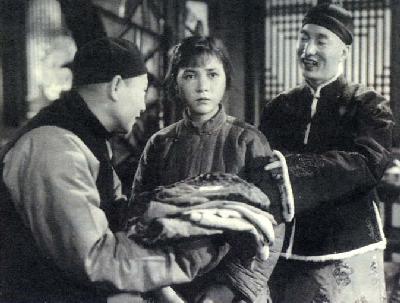The most outstanding representative film soon after the founding of the People's Republic of China isThe White-Haired Girl, co-directed by Wang Bin and Shui Hua. It is based on the legend of a white-haired female immortal. It tells of Yang Bailao, a tenant farmer who shares his life with his daughter Xi'er. The despotic landlord, Huang Shiren, attempts to forcibly take Xi'er for himself. On the eve of the Chinese Spring Festival, Huang forces Yang to sell his daughter as repayment of the debt Yang owes him. Yang drinks bittern and dies. Xi'er is taken by force to Huang's house and raped by the landlord.
 |
| A scene from The While-Haired Girl |
The girl is in love with Dachun, a young farmer in her village, who tries to help her escape but fails. He goes to find the Red Army. Xi'er runs away from Huang's house and hides herself deep in the mountains. She leads a miserable life, and her hair urns completely white. Two years later, Dachun returns to the village with the army unit he is in. He finds Xi'er and helps her get even with the hated landlord. They marry and lead a happy life after emancipation. The film shows the oppression suffered by millions upon millions of Chinese peasants in the Chinese society before 1949 by describing the fate of the leading character and showing the theme that "the old society turned a person into a ghost and the new society turns the ghost back into a person".
Xi'er was not only the sufferer of the oppression caused by the old society but also a girl who showed the resistant spirit of the laboring people. The film had a distinct national style with its integrated plot and artistic form. It combined analogue with montage and used comparison of the atmosphere and coordination of the plot to achieve a high artistic effect.The White-Haired Girlwas an important effort to explore a national style in the China's films after 1949. In 1951, it won the Special Honorary Prize at the Sixth Karlovy Cary International Film Festival. More than six million people watched the film in the first round of release in China. In the 1950s, it was screened in more than 30 countries and regions. The French cinema historian Georges Sadoul set a great value on the film in his bookAnnals of the Cinematographic Art.
